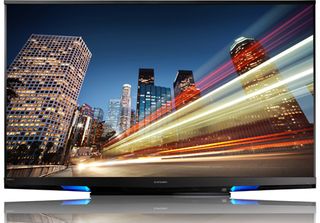Think Mitsubishi, and most UK enthusiasts will probably visualise one of these,
while the plane-spotters on the WHFSV Forums will probably think...

However, Mitsubishi Electric is a TV force to be reckoned with in its home country, Japan, not to mention the States: true, its sales figures won't trouble the giants of the global telly industry, such as Samsung and LG, but when it comes to bang for your buck, not to mention technological innovation, it has plenty to offer.

How about a 73in TV for $1599, or just over £1000? OK, so it doesn't do 3D – if the lack of SwimmyVision™'s a problem for you – but the company can also do you an 82in (above) for around £1700.

Meanwhile others in the range do offer 3D, and go right up to a flagship 92in model (above), on sale next month for $5999, or around £3785.
That's still a lot of TV for the money, especially when you also get no fewer than 16 speakers built-in to create what the company calls Immersive Sound Technology, preout sockets for surround speakers and extra subwoofers, StreamTV internet capability and iOS device app control.
How's it done? Well, it's a simple matter of a screen technology you may have thought had long been consigned to the garbage can – sorry, recycling container – of TV history: rear-projection.
The big Mitsubishis – the company's just launched ten new models in the States, from the entry-level C12 series up to the flagship 842 line – all use the same kind of DLP (Digital Light Processing) technology you'll find in many a projector, firing backwards into a mirror and then onto the rear of the screen you watch.
As Mitsubishi Electric Visual Solutions America's Max Wasinger puts it, 'There is no question that "bigger is better", so we're introducing large screens that give consumers an unmatched viewing experience for movies, sports, gaming and 3D content.
'As we maintain our size advantage in the television market, we've also built in more value and features for consumers who demand TVs with bigger screens and better sound at prices that meet their budget."


But just in case you thought Mitsubishi was all about a technology predating large plasma and LCD displays, it also sells its LaserVue TVs in the States, with a new model – the 75in L75-A96 (above) – added as part of the new range.
Using a laser light engine to do the rear projection, the TV sells for $5999, or around the same price as that top-end DLP model, and has the advantage of greatly reduced power consumption, putting it well within US Energy Star requirements.
It also gives a much slimmer profile (left) than conventional projector-based rear-projection TVs. OK, it's not LCD or plasma slim, but compared with the behemoths of rear-projection's past, it's getting there.
But Mitsubishi is going further back in Japan, with the launch of its Real LaserVue LCD TV, due in the shops at the end of June.
Yes, it's a 55in laser-lit LCD TV, or at least one using a hybrid LCD/laser lighting system, employing 32 lasers and 160 LEDs, mounted on both sides of the display.
Why lasers? Well, the company says the red lasers not surprisingly produce very pure reds, while the cyan LEDs it uses are best for blues and greens, and between them the two technologies produce a spectrum of colour around 30% greater than its existing LCD TVs using white LED backlighting.

It plans to make around 3000 of the TVs a month, and they'll sell for around Y380,000 (just over £3000) a pop, complete with 3D capability and onboard Diatone NCV audio technology using ten drive units.
Oh, and the set also includes three internal tuners for digital TV, a 1TB hard drive for recording off-air and storing content, and an onboard Blu-ray player/burner.
Bad news? It's Japan-only...
